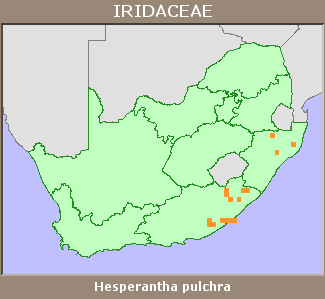|
Scientific Name | Hesperantha pulchra Baker |
Higher Classification | Monocotyledons |
Family | IRIDACEAE |
National Status |
Status and Criteria | Least Concern |
Assessment Date | 2021/06/21 |
Assessor(s) | W. Foden, L. Potter & T. Patel |
Justification | This species has an extent of occurrence (EOO) of 91 118 km², and an area of occupancy (AOO) of 68 km². It is known from between 15 and 20 subpopulations and has no known threats. It is therefore listed as Least Concern. |
Distribution |
Endemism | South African endemic |
Provincial distribution | Eastern Cape, KwaZulu-Natal |
Range | This species is endemic to South Africa, and extends from the Amatole Mountains of Eastern Cape north to Naude's Nek. |
Habitat and Ecology |
Major system | Terrestrial |
Major habitats | Grassland, Savanna |
Description | It occurs in rocky grassland. |
Threats |
| This species has no known threats. |
Population |
It is spread between 15 to 20 subpopulations. Records give no indication of this species' population size but the population is inferred to be stable as there are no known threats.
|
Population trend | Stable |
Assessment History |
Taxon assessed |
Status and Criteria |
Citation/Red List version | | Hesperantha pulchra Baker | Least Concern | Raimondo et al. (2009) | |
Bibliography |
Goldblatt, P. and Manning, J.C. 2020. Iridaceae of southern Africa. Strelitzia 42. South African National Biodiversity Institute, Pretoria.
Raimondo, D., von Staden, L., Foden, W., Victor, J.E., Helme, N.A., Turner, R.C., Kamundi, D.A. and Manyama, P.A. 2009. Red List of South African Plants. Strelitzia 25. South African National Biodiversity Institute, Pretoria.
|
Citation |
| Foden, W., Potter, L. & Patel, T. 2021. Hesperantha pulchra Baker. National Assessment: Red List of South African Plants version 2024.1. Accessed on 2025/10/26 |
 Comment on this assessment
Comment on this assessment


